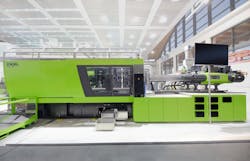Electric IMMs can handle some thin-wall applications
By Bruce Geiselman
Engel, a worldwide manufacturer of injection molding machines (IMMs), has seen increased interest in recent years in using electric presses to produce thin-wall packaging, something that was previously uncommon.
“We have seen more electric machines being used in thin-wall packaging, which we pioneered,” said James Overbeeke, business development manager for packaging in North America at Engel.
Until recent years, only hydraulic IMMs had fast-enough injection rates. However, Engel and other manufacturers now are touting improved electric machines that are capable of at least some thin-wall injection molding, Overbeeke said.
“We started with closures with our e-cap machine,” Overbeeke said. “We also have the e-motion machine, which has been used for many packaging applications, as well.”
E-cap IMMs are all-electric toggle-clamp presses designed for the efficient production of plastic caps and closures. Engel says users can reduce production costs with cycle times of less than 2 seconds. The company says users also can save as much as 50 percent on energy costs. The e-cap line is available in models with a clamping force ranging from 247 tons to 472 tons.
E-motion machines are suited for applications in the packaging sector and in medical technology, according to Engel. The e-motion models require minimal power consumption and short cycle times, according to the company. They are available with clamping forces ranging from 33 tons to 730 tons.
The all-electric machines are particularly popular in Europe where energy costs are high, Overbeeke said. However, demand is increasing in North America, and the appeal of all-electric machines is not limited to energy efficiency.
“It’s not just energy, it’s also not needing to maintain hydraulic servo valves, which can be delicate, and [eliminating] oil maintenance,” Overbeeke said. “There is a lower maintenance cost to looking after a servo motor.”
The transition toward using electric IMMs for certain thin-wall projects has taken place over the past decade.
“Ten years ago, you wouldn’t dream of putting an electric machine into most thin-wall packaging applications,” Overbeeke said. “Today, it definitely is possible, and it’s worth considering because of the energy cost, cleanliness, and maintenance costs.”
While the popularity of all-electric IMMs is increasing, presses with hydraulic injection systems still are better suited for stack molds and higher-performance applications, Overbeeke said.
“To do a thin-wall container, you need a certain speed and acceleration rate,” he said. “Hydraulics are still the best for the extreme thin-wall. The highest performance is still the hydraulics.”
At the 2022 K Show, Engel demonstrated how an e-speed hybrid unit — featuring a hydraulic injection system with an electric clamp and electric plasticizing unit — could process recycled PET (rPET) in thin-wall injection molding applications. Engel hailed it as a “quantum leap” for the packaging industry as it was the first time that thin-walled containers made of PET or rPET could be produced in a single step.
Previously, it was possible to injection mold PET only in thick-walled parts, such as bottle preforms, according to Engel. The final packaging format was created in a second step of the process, by blow molding for example.
The K Show cell featured an Engel e-speed 280/50 IMM equipped with a new high-performance injection unit, which made the PET thin-wall packaging possible, according to the company. The injection unit can reach injection speeds of up to 55 inches per second at a maximum injection pressure of up to 37,709 pounds per square inch.
The cell produced transparent 125-milliliter containers with a wall thickness of 0.32mm.
Technology has improved in recent years for both hydraulic and electric IMMs. “But I would say that there are more electric machines today in thin-wall packaging than there were even five years ago,” Overbeeke said.
When deciding whether to select an electric or a hydraulic IMM for a particular project, Overbeeke suggested looking at the flow-length-to wall-thickness ratio, or L/T ratio.
“A relatively easy part to mold would be 200 L/T,” Overbeeke said. “Then you go up from there. I would say it gets more challenging when you hit 300 L/T. At 200, you could for sure do electric. At 300, you would need to do hydraulic. And then in between those numbers is where you have to do some testing.”
The demand for thin-wall packaging has been fairly stable with incremental growth tied to the growth of the population, Overbeeke said. However, Engel saw an increase in demand for thin-wall packaging equipment sales during the COVID pandemic, especially for use with food packaging.
“We had quite a rush of business through COVID, and inventories are probably high right now, where people did some buying for security,” Overbeeke said. “The market was growing because people were buying product. The molders were busy, and so, they bought more equipment. Now, that surge has calmed down or retracted a bit.”
One of the most compelling reasons that has fueled the popularity of thin-wall molding is resin prices.
“Material is still the biggest cost of a thin-wall container, by far, more than energy costs, more than labor costs and more than everything,” Overbeeke said. “There have been tremendous gains based on economics — not necessarily sustainability or the environment — but there has been a reduction of wall section just for the cost reduction and competitiveness.”
Contact:
Engel Machinery Inc., York, Pa., 717-764-6818, www.engelglobal.com
About the Author
Bruce Geiselman
Senior Staff Reporter Bruce Geiselman covers extrusion, blow molding, additive manufacturing, automation and end markets including automotive and packaging. He also writes features, including In Other Words and Problem Solved, for Plastics Machinery & Manufacturing, Plastics Recycling and The Journal of Blow Molding. He has extensive experience in daily and magazine journalism.
